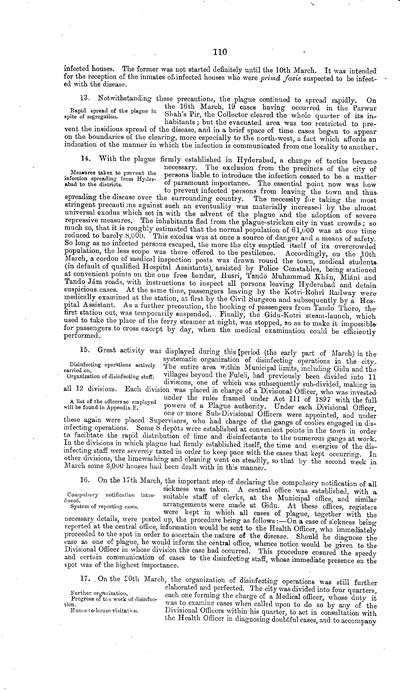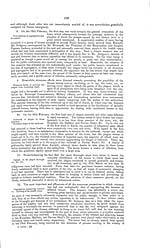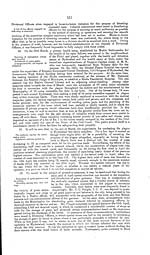Medicine - Disease > Account of plague administration in the Bombay Presidency from September 1896 till May 1897
(122) Page 110
Download files
Individual page:
Thumbnail gallery: Grid view | List view

110
infected houses. The former was not started definitely until the 10th March. It was intended
for the reception of the inmates of infected houses who were prim facie suspected to be infect-
ed with the disease.
Rapid spread of the plague in
spite of segregation.
13. Notwithstanding these precautions, the plague continued to spread rapidly. On
the 16th March, 19 cases having occurred in the Parwar
Shah's Pir, the Collector cleared the whole quarter of its in-
habitants ; but the evacuated area was too restricted to pre-
vent the insidious spread of the disease, and in a brief space of time cases began to appear
on the boundaries of the clearing, more especially to the north-west, a fact which affords an
indication of the manner in which the infection is communicated from one locality to another.
Measures taken to prevent the
infection spreading from Hyder-
abad to the districts.
14. With the plague firmly established in Hyderabad, a change of tactics became
necessary. The exclusion from the precincts of the city of
persons liable to introduce the infection ceased to be a matter
of paramount importance. The essential point now was how
to prevent infected persons from leaving the town and thus
spreading the disease over the surrounding country. The necessity for taking the most
stringent precautions against such an eventuality was materially increased by the almost
universal exodus which set in with the advent of the plague and the adoption of severe
repressive measures. The inhabitants fled from the plague-stricken city in vast crowds ; so
much so, that it is roughly estimated that the normal population of 61,000 was at one time
reduced to barely 8,000. This exodus was at once a source of danger and a means of safety.
So long as no infected persons escaped, the more the city emptied itself of its overcrowded
population, the less scope was there offered to the pestilence. Accordingly, on the 10th
March, a cordon of medical inspection posts was drawn round the town, medical students
(in default of qualified Hospital Assistants), assisted by Police Constables, being stationed
at convenient points on the one free bandar, Husri, Tando Muhammad Khn, Mini and
Tando Jm roads, with instructions to inspect all persons leaving Hyderabad and detain
Suspicious cases. At the same time, passengers leaving by the Kotri-Rohri Railway were
medically examined at the station, at first by the Civil Surgeon and subsequently by a Hos-
pital Assistant. As a further precaution, the booking of passengers from Tando Thoro, the
first station out, was temporarily suspended. Finally, the Gidu-Kotri steam-launch, which
used to take the place of the ferry steamer at night, was stopped, so as to make it impossible
for passengers to cross except by day, when the medical examination could be efficiently
performed.
Disinfecting operations actively
carried on.
Organization of disinfecting staff.
A list of the officers so employed
will be found in Appendix E.
15. Great activity was displayed during this [period (the early part of March) in the
systematic organization of disinfecting operations in the city.
The entire area within Municipal limits, including Gidu and the
villages beyond the Fuleli, had previously been divided into 11
divisions, one of which was subsequently sub-divided, making in
all 12 divisions. Each division was placed in charge of a Divisional Officer, who was invested
under the rules framed under Act III of 1897 with the full
powers of a Plague authority. Under each Divisional Officer,
one or more Sub-Divisional Officers were appointed, and under
these again were placed Supervisors, who had charge of the gangs of coolies engaged in dis-
infecting operations. Some 8 depts were established at convenient points in the town in order
to facilitate the rapid distribution of lime and disinfectants to the numerous gangs at work.
In the divisions in which plague had firmly established itself, the time and energies of the dis-
infecting staff were severely taxed in order to keep pace with the cases that kept occurring. In
other divisions, the limewashing and cleaning went on steadily, so that by the second week in
March some 3,000 houses had been dealt with in this manner.
Compulsory notification intro-
duced.
System of reporting cases.
16. On the 17th March, the important step of declaring the compulsory notification of all
sickness was taken. A central office was established, with a
suitable staff of clerks, at the Municipal office, and similar
arrangements were made at Gidu. At these offices, registers
were kept in which all cases of plague, together with the
necessary details, were posted up, the procedure being as follows :-On a case of sickness being
reported at the central office, information would be sent to the Health Officer, who immediately
proceeded to the spot in order to ascertain the nature of the disease. Should he diagnose the
case as one of plague, he would inform the central office, whence notice would be given to the
Divisional Officer in whose division the case had occurred. This procedure ensured the speedy
and certain communication of cases to the disinfecting staff, whose immediate presence on the
spot was of the highest importance.
Further organization.
Progress of the work of disinfec-
tion .
House-to-house visitation.
17. On the 20th March, the organization of disinfecting operations was still further
elaborated and perfected. The city was divided into four quarters,
each one forming the charge of a Medical officer, whose duty it
was to examine cases when called upon to do so by any of the
Divisional Officers within his quarter, to act in consultation with
the Health Officer in diagnosing doubtful cases, and to accompany
infected houses. The former was not started definitely until the 10th March. It was intended
for the reception of the inmates of infected houses who were prim facie suspected to be infect-
ed with the disease.
Rapid spread of the plague in
spite of segregation.
13. Notwithstanding these precautions, the plague continued to spread rapidly. On
the 16th March, 19 cases having occurred in the Parwar
Shah's Pir, the Collector cleared the whole quarter of its in-
habitants ; but the evacuated area was too restricted to pre-
vent the insidious spread of the disease, and in a brief space of time cases began to appear
on the boundaries of the clearing, more especially to the north-west, a fact which affords an
indication of the manner in which the infection is communicated from one locality to another.
Measures taken to prevent the
infection spreading from Hyder-
abad to the districts.
14. With the plague firmly established in Hyderabad, a change of tactics became
necessary. The exclusion from the precincts of the city of
persons liable to introduce the infection ceased to be a matter
of paramount importance. The essential point now was how
to prevent infected persons from leaving the town and thus
spreading the disease over the surrounding country. The necessity for taking the most
stringent precautions against such an eventuality was materially increased by the almost
universal exodus which set in with the advent of the plague and the adoption of severe
repressive measures. The inhabitants fled from the plague-stricken city in vast crowds ; so
much so, that it is roughly estimated that the normal population of 61,000 was at one time
reduced to barely 8,000. This exodus was at once a source of danger and a means of safety.
So long as no infected persons escaped, the more the city emptied itself of its overcrowded
population, the less scope was there offered to the pestilence. Accordingly, on the 10th
March, a cordon of medical inspection posts was drawn round the town, medical students
(in default of qualified Hospital Assistants), assisted by Police Constables, being stationed
at convenient points on the one free bandar, Husri, Tando Muhammad Khn, Mini and
Tando Jm roads, with instructions to inspect all persons leaving Hyderabad and detain
Suspicious cases. At the same time, passengers leaving by the Kotri-Rohri Railway were
medically examined at the station, at first by the Civil Surgeon and subsequently by a Hos-
pital Assistant. As a further precaution, the booking of passengers from Tando Thoro, the
first station out, was temporarily suspended. Finally, the Gidu-Kotri steam-launch, which
used to take the place of the ferry steamer at night, was stopped, so as to make it impossible
for passengers to cross except by day, when the medical examination could be efficiently
performed.
Disinfecting operations actively
carried on.
Organization of disinfecting staff.
A list of the officers so employed
will be found in Appendix E.
15. Great activity was displayed during this [period (the early part of March) in the
systematic organization of disinfecting operations in the city.
The entire area within Municipal limits, including Gidu and the
villages beyond the Fuleli, had previously been divided into 11
divisions, one of which was subsequently sub-divided, making in
all 12 divisions. Each division was placed in charge of a Divisional Officer, who was invested
under the rules framed under Act III of 1897 with the full
powers of a Plague authority. Under each Divisional Officer,
one or more Sub-Divisional Officers were appointed, and under
these again were placed Supervisors, who had charge of the gangs of coolies engaged in dis-
infecting operations. Some 8 depts were established at convenient points in the town in order
to facilitate the rapid distribution of lime and disinfectants to the numerous gangs at work.
In the divisions in which plague had firmly established itself, the time and energies of the dis-
infecting staff were severely taxed in order to keep pace with the cases that kept occurring. In
other divisions, the limewashing and cleaning went on steadily, so that by the second week in
March some 3,000 houses had been dealt with in this manner.
Compulsory notification intro-
duced.
System of reporting cases.
16. On the 17th March, the important step of declaring the compulsory notification of all
sickness was taken. A central office was established, with a
suitable staff of clerks, at the Municipal office, and similar
arrangements were made at Gidu. At these offices, registers
were kept in which all cases of plague, together with the
necessary details, were posted up, the procedure being as follows :-On a case of sickness being
reported at the central office, information would be sent to the Health Officer, who immediately
proceeded to the spot in order to ascertain the nature of the disease. Should he diagnose the
case as one of plague, he would inform the central office, whence notice would be given to the
Divisional Officer in whose division the case had occurred. This procedure ensured the speedy
and certain communication of cases to the disinfecting staff, whose immediate presence on the
spot was of the highest importance.
Further organization.
Progress of the work of disinfec-
tion .
House-to-house visitation.
17. On the 20th March, the organization of disinfecting operations was still further
elaborated and perfected. The city was divided into four quarters,
each one forming the charge of a Medical officer, whose duty it
was to examine cases when called upon to do so by any of the
Divisional Officers within his quarter, to act in consultation with
the Health Officer in diagnosing doubtful cases, and to accompany
Set display mode to: Large image | Zoom image | Transcription
Images and transcriptions on this page, including medium image downloads, may be used under the Creative Commons Attribution 4.0 International Licence unless otherwise stated. ![]()
| India Papers > Medicine - Disease > Account of plague administration in the Bombay Presidency from September 1896 till May 1897 > (122) Page 110 |
|---|
| Permanent URL | https://digital.nls.uk/74517254 |
|---|




